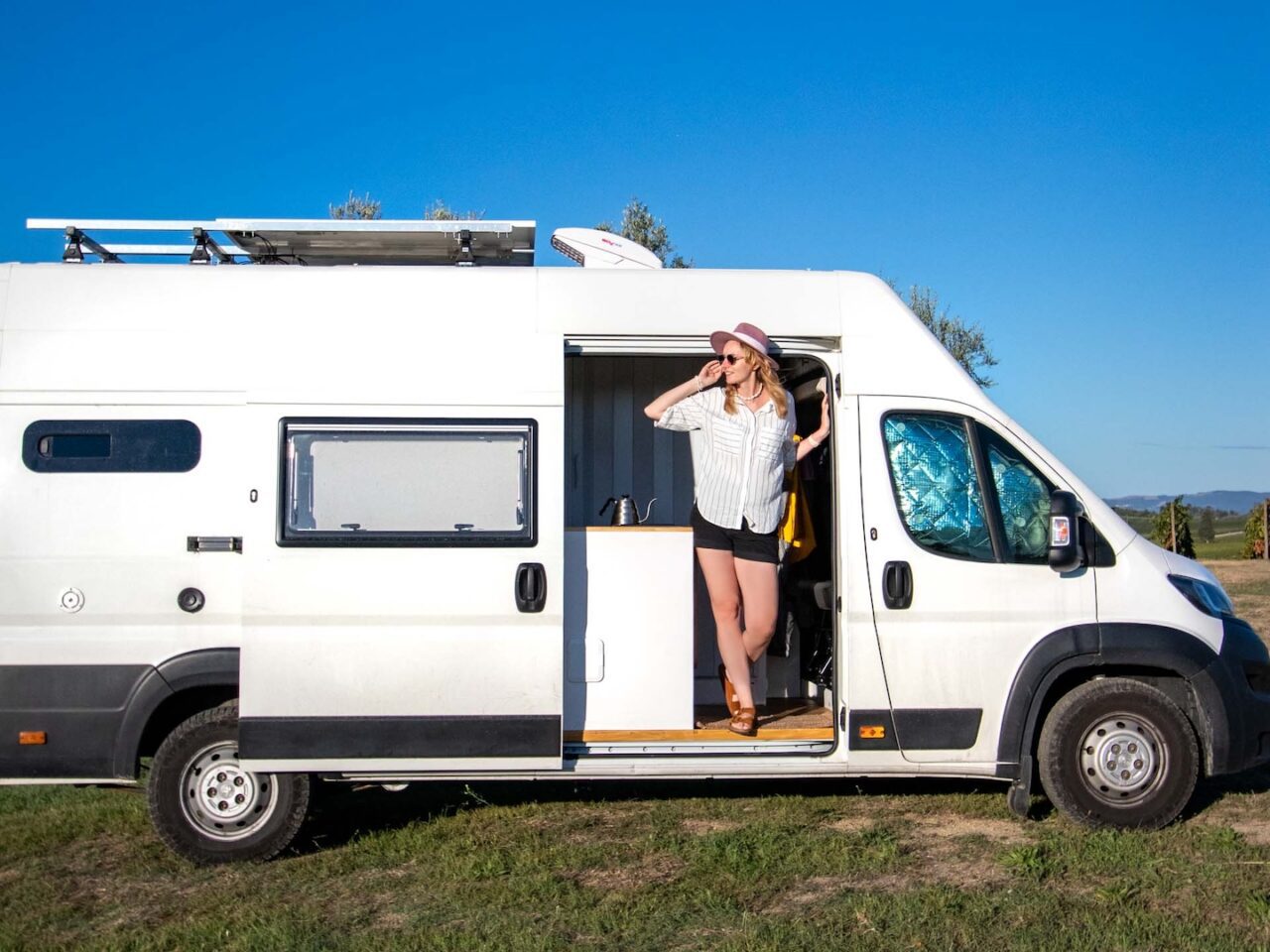Thinking about how to build a campervan? Trust me, you’re not alone!
I found myself down this exact rabbit hole last year, and now that my husband and I have finished our own build, I wanted to share everything we learned along the way.
This guide comes straight from our personal experience – the mistakes, the victories, and all the “I wish someone had told me that” moments.
I’ve tried to organize everything into the steps that made sense for us, from initial planning through to our first road trip.
So grab a coffee (or something stronger), and let’s talk about turning an empty van into your dream home on wheels!
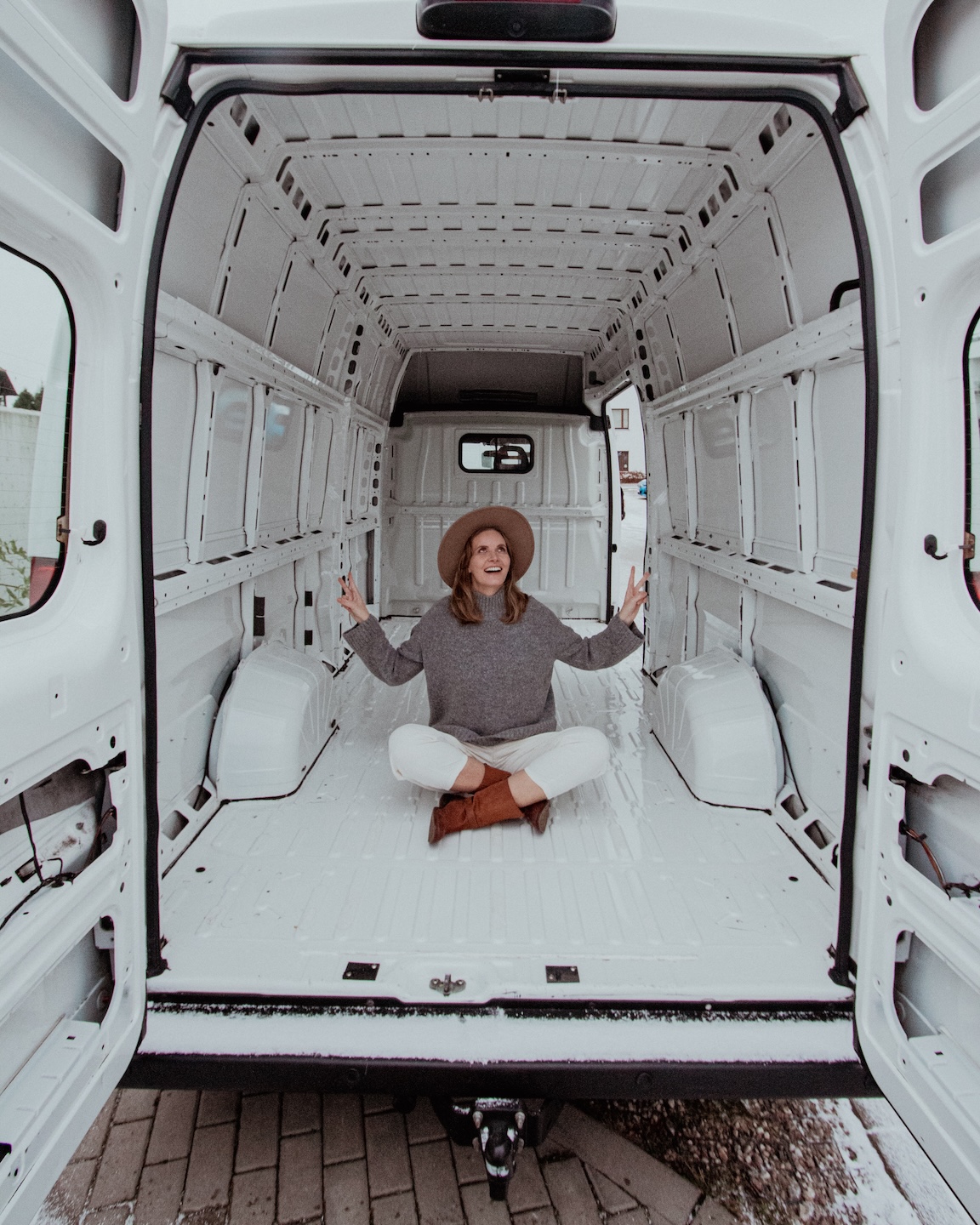
1. How to Build a Campervan: Planning Your Layout
Looking back, I’m so glad we spent weeks obsessing over our layout before buying a single screw. This initial planning shaped everything that followed.
We started by sketching out rough ideas, pinning inspiration photos, and having long discussions about what we actually needed. Eventually, we even made a small cardboard model because, let me tell you, space is TIGHT!
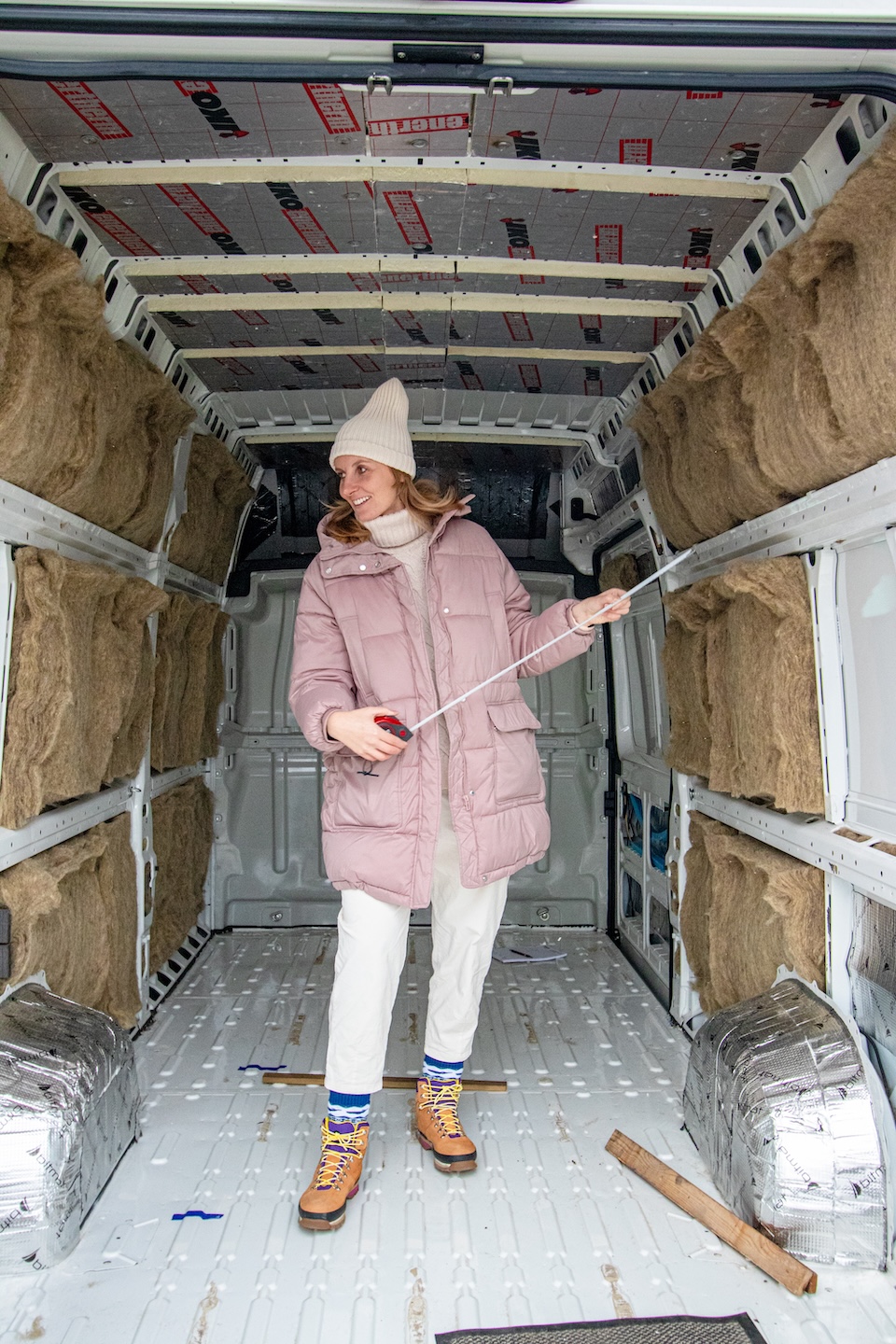
When planning your own layout, here’s what I’d recommend thinking about:
- Bed size and placement – We debated this forever! Do you want it to run lengthwise or across the van? This is probably the most important decision you’ll make.
- Bathroom situation – Do you want one? They’re amazing to have but take up valuable space and add complexity.
- How many people? – More passengers means more seats with seatbelts, which means less living space.
- Kitchen priorities – Most layouts include some form of kitchen, often near the sliding door for ventilation.
- Work/relax space – If you’ll be working remotely or just want somewhere comfortable to sit that isn’t your bed, you’ll need to plan for that.
- Storage for your stuff – Need to bring bikes, surfboards, or other bulky gear? You’ll need a “garage” space.
- Weight considerations – It’s not just about fitting everything in-your van has weight limits too. In Europe, campervans are limited to 3.5 tons.
Our Build
In our van build, we designed a pull-out bed that’s 180 cm x 200 cm (70.9 inches x 78.7 inches), giving us plenty of space to sleep across the van. Building it took some work, but the end result was totally worth it.
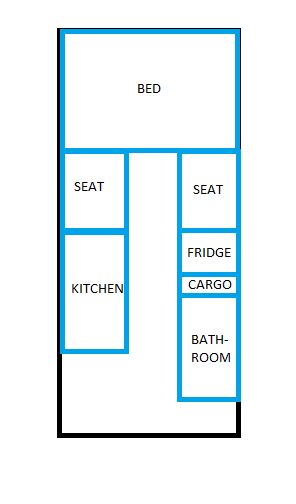
For our build, we finally decided on a pull-out bed measuring 180 × 200 cm (71 × 79 inches) that runs across the width of the van. It was tricky to build but totally worth it for the comfort.
We also squeezed in a tiny bathroom (100 × 60 cm or 39 × 24 inches) with a shower and toilet, a kitchen area (120 × 65 cm or 47 × 26 inches), and a flexible dining/working space with a movable table.
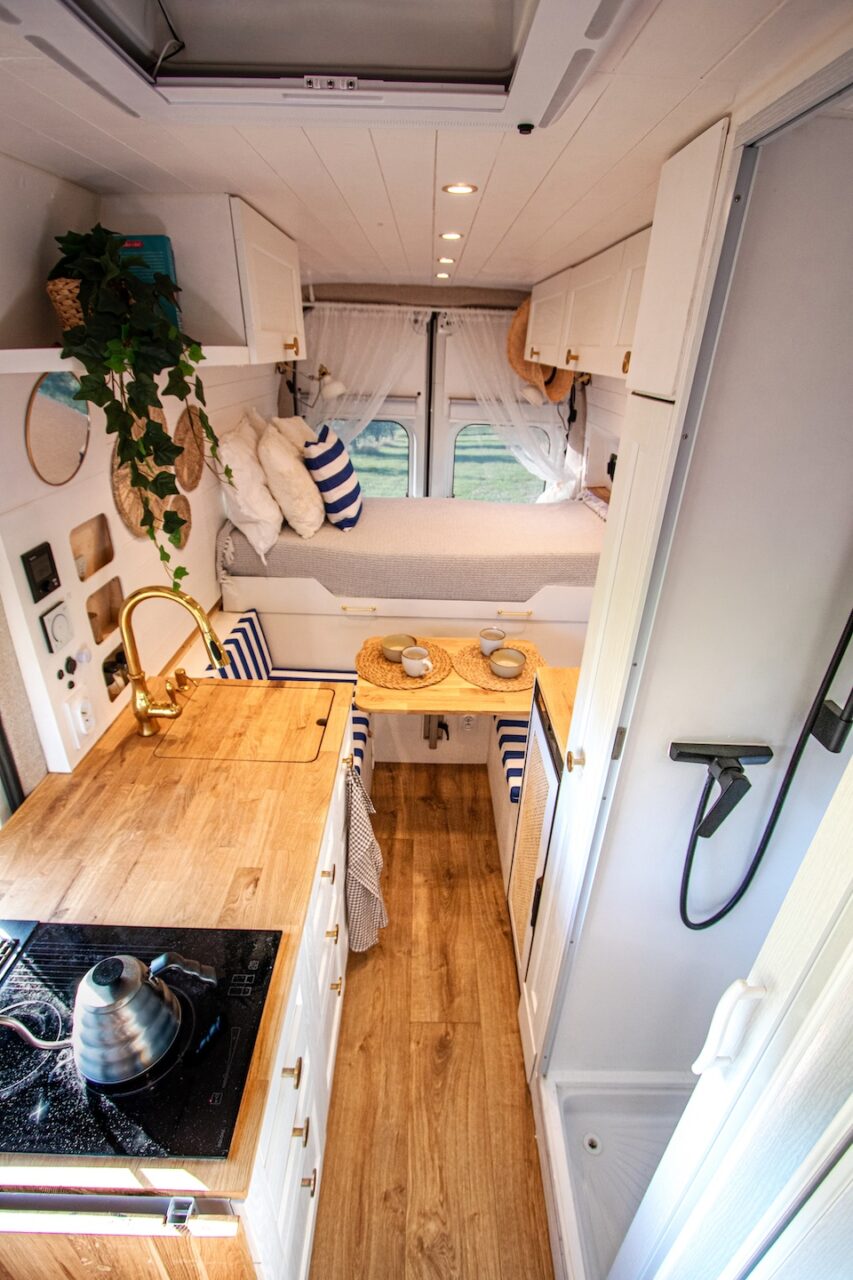
If you’re stuck on layout ideas, definitely check out my 10 Ingenious Van Build Layout Ideas You Need to See → I share some incredibly creative solutions that might spark your own design!
2. Choosing Your Van: The Big Decision
After weeks of research and visiting dealerships, we had to make a choice. The van you pick will determine so much about your build, particularly the dimensions and engine type.
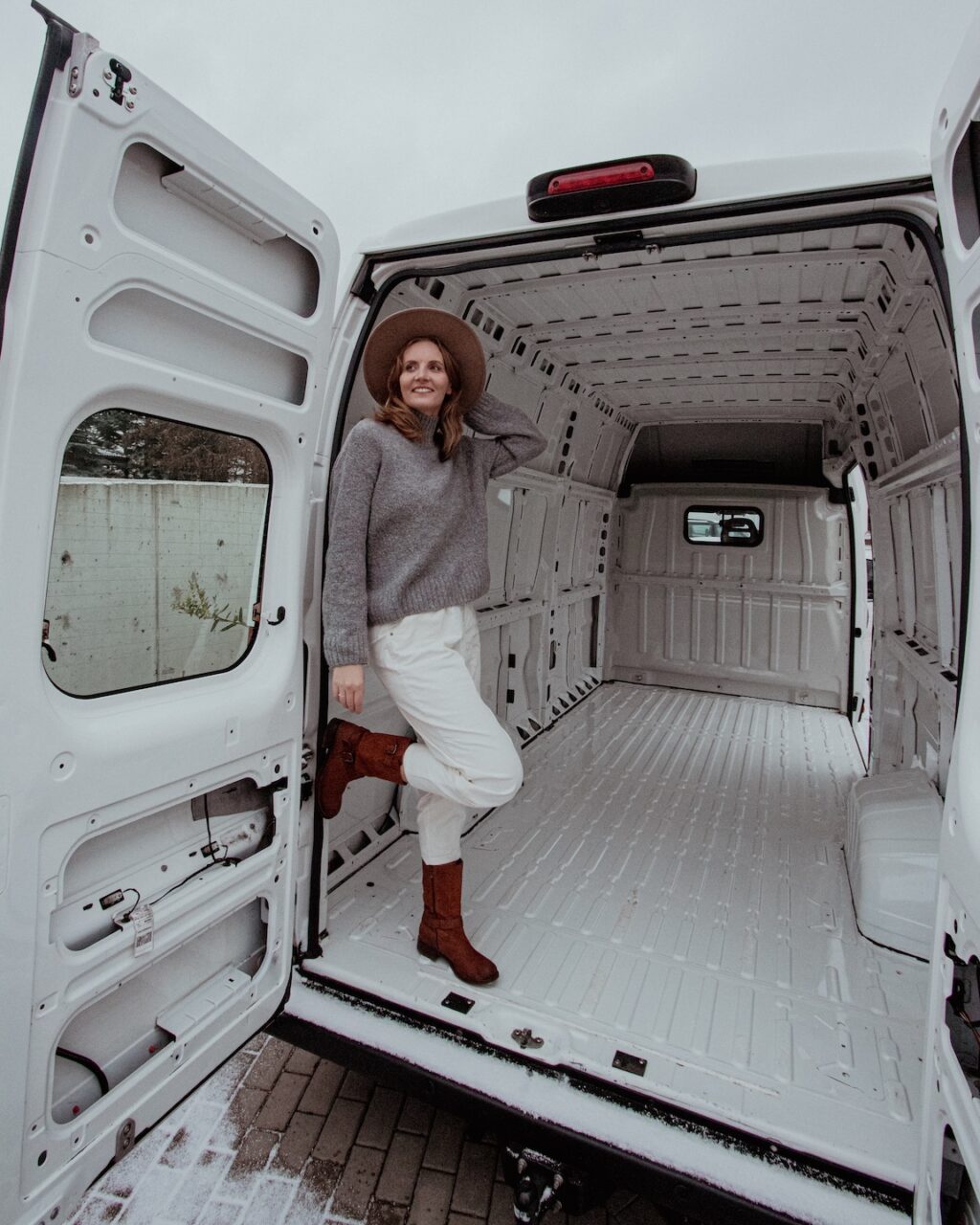
These were our top contenders:
The “Triplets”: Ducato, Boxer, Jumper (Ram ProMaster in the US)
These three vans are basically identical under different brand names. We loved them because:
- They’re built on the same platform, so parts and accessories are interchangeable
- The wider body allows for a bed across the width (great for taller people)
- There are various engine options to suit different needs
If you’re over 195 cm (6’5″) tall, you’ll definitely want the high–roof version!
Ford Transit
The Transit comes in several variants including jumbo and 4×4 models. It’s a great choice if you:
- Want a bed that fits inside the van
- Prefer a 4×4 option
- Want a newer model with an engine under 2.0 liters
Mercedes Sprinter & VW Crafter
These are perfect for larger builds. They’re longer but narrower, giving you more overall space to work with.
In the end, we went with the Peugeot Boxer.
It had plenty of space (especially important for my tall husband), and the 2.0L engine helped keep our road taxes lower. It also had the best selection of compatible accessories, which made our build easier.
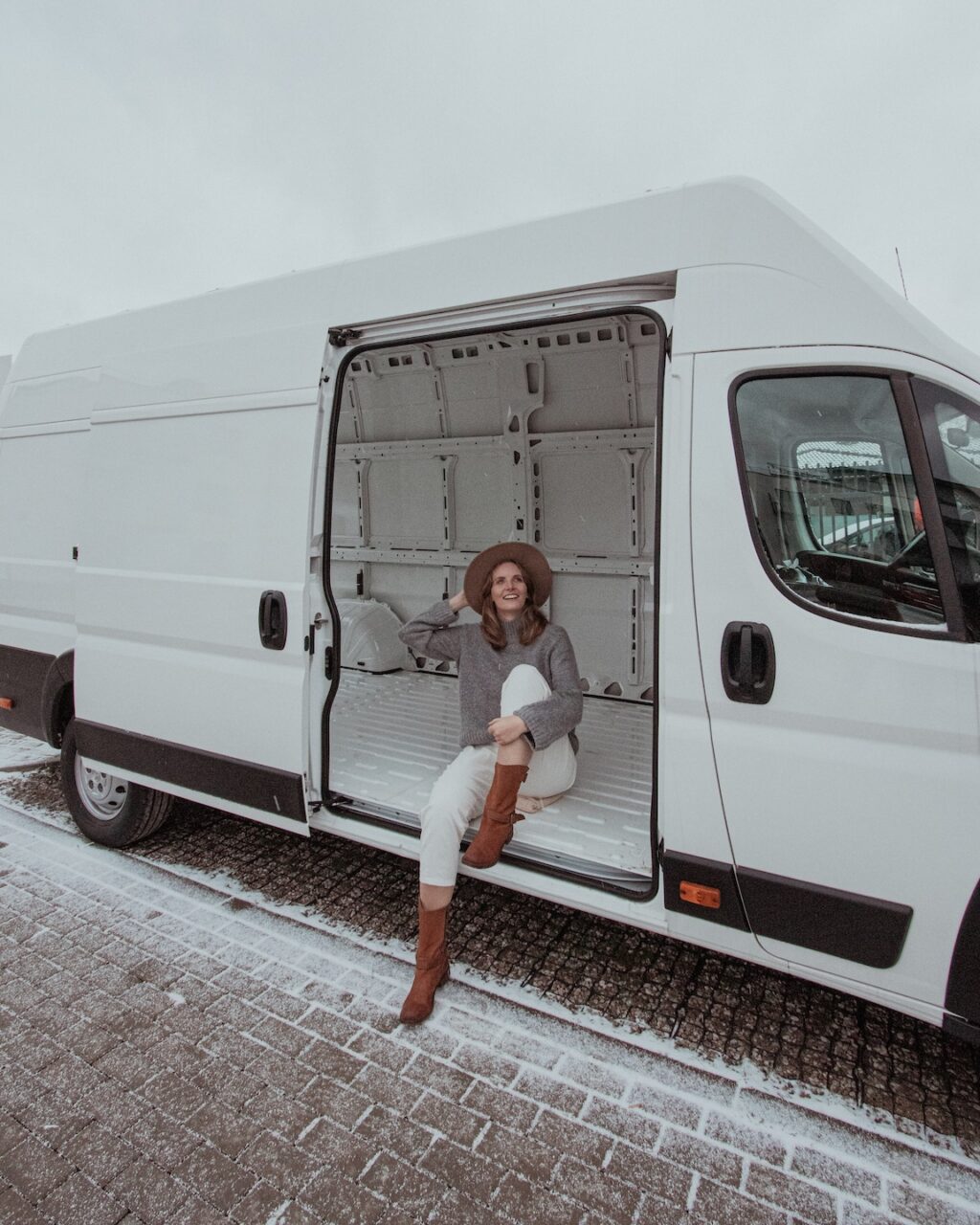
3. Windows and External Modifications
Once we had our van, the first big step was cutting holes for windows and vents.
Let me tell you, taking a saw to your brand-new van is TERRIFYING, but adding natural light makes such a difference!
We installed:
- A side window
- A roof fan (MaxxAir MaxxFan)
- Two small rear windows (80 × 20 cm or 31 × 8 inches) for cross-ventilation behind the bed
We also added a water inlet connection, external charging sockets, a small bathroom vent, and a 4G+WiFi antenna on the roof.
If you’re going solar (which I highly recommend), make sure to install a proper grommet for the cables between your panels and the solar controller.
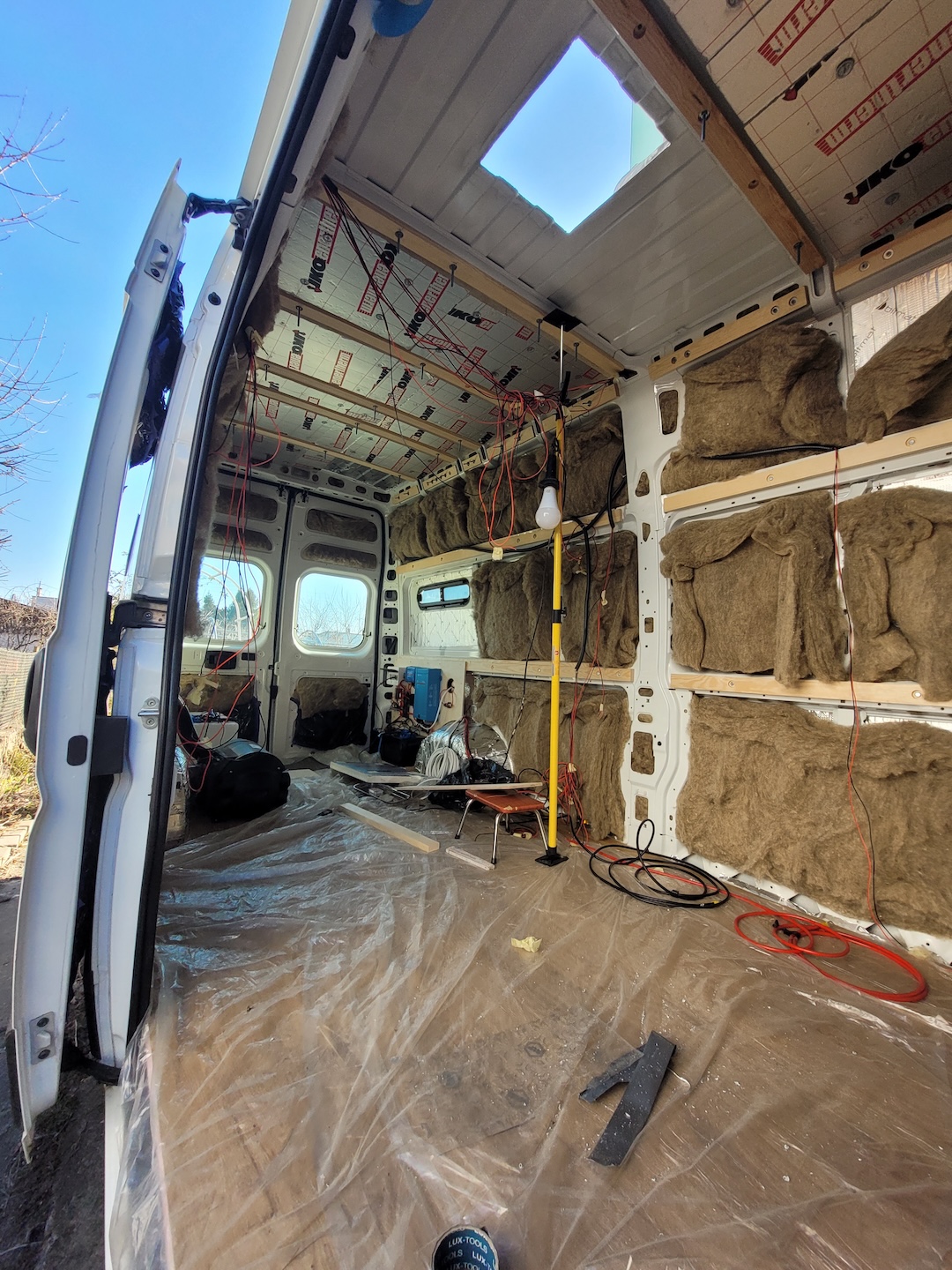
4. Insulation: Don’t Skip This Step!
Year-Round vs. Seasonal Use
Insulation might not be the sexiest part of a van build, but it’s SO important.
Good insulation keeps you warm in winter, cool in summer, and helps prevent condensation (which can lead to mold and rust).
For our van, we used a combination of:
- Polyethylene foam
- XPS board
- Sheep wool (my favorite- it’s natural and non-toxic)
- PIR boards
- Alufox reflective insulation
We finished the walls and ceiling with 9 mm (0.35 inch) wooden paneling painted white to brighten up the space.
We also used butyl mats for soundproofing. Just be aware that these are heavy, so you need to balance noise reduction with weight concerns.

5. Electrical System: Power for Everything
Electricity powers almost everything in your van – lights, water pump, heating, refrigerator, device charging, etc.
Our electrical system consists of:
- A 200 Ah “leisure” battery (separate from the vehicle’s battery)
- 350W of solar panels on the roof
- A smart converter that can charge from external 230V sources and from the alternator while driving
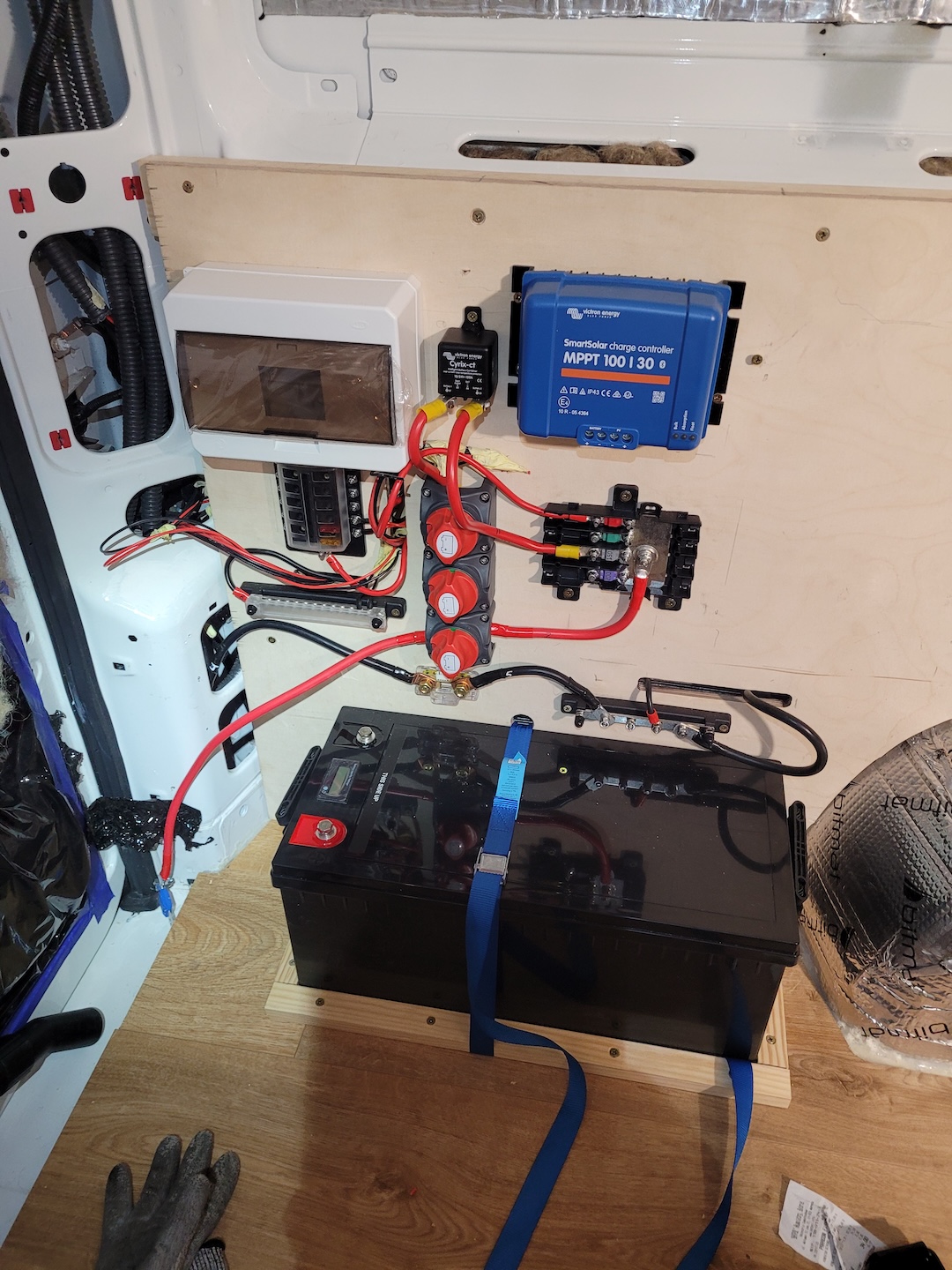
This setup gives us enough power to run laptops, the fridge, and other essentials without worrying too much about running out.
We have both 12V (direct from the battery) and 230V (through the converter) outlets throughout the van. Most camper-specific appliances run on 12V, while regular household items need 230V.
6. Water, Gas, and Heating
For fresh water, we installed a tank connected to an electric pump that sends water to our sink and shower. We also added a gas-powered flow heater that provides hot water and heats the living area.
All used water (from the sink and shower) goes into a gray water tank mounted underneath the van. This is crucial for responsible camping!
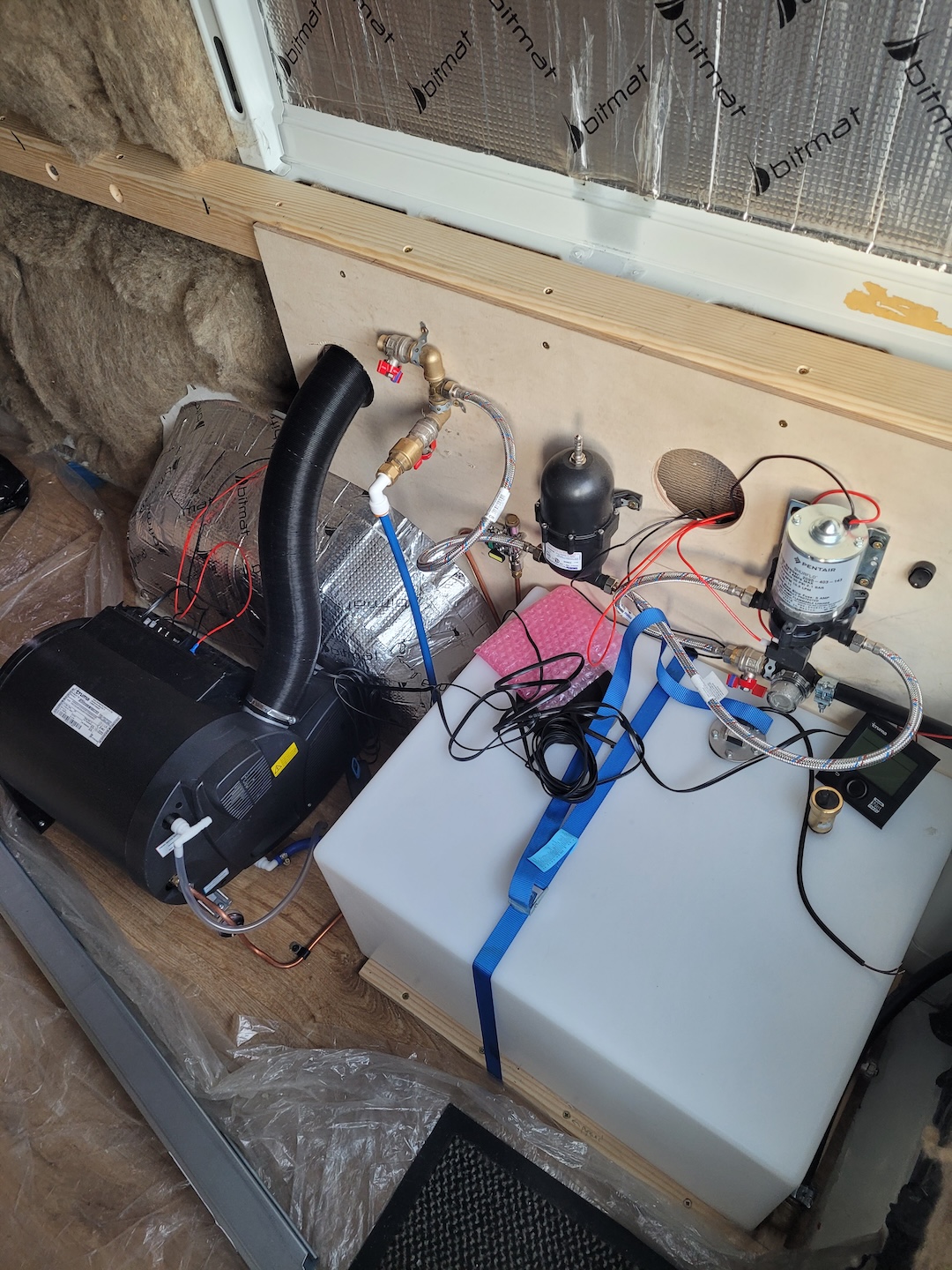
Ready to tackle your own van conversion but feeling overwhelmed by all the details?
I share every step of my build process, complete with mistakes to avoid and money-saving tips from my own experience.
Sign up to grab my Ultimate Van Build Checklist and kickstart your conversion!

7. Bed Design: Your Home’s Heart
The bed is probably the most important part of your campervan – after all, you’ll spend about a third of your time in it!
We debated between:
- Fixed platform bed – Simplest to build, but takes up permanent space
- Pull-out bed – More complex but saves space during the day
- Dinette conversion – Gives more seating but less storage
- Murphy/wall bed – Space-saving but complex to build
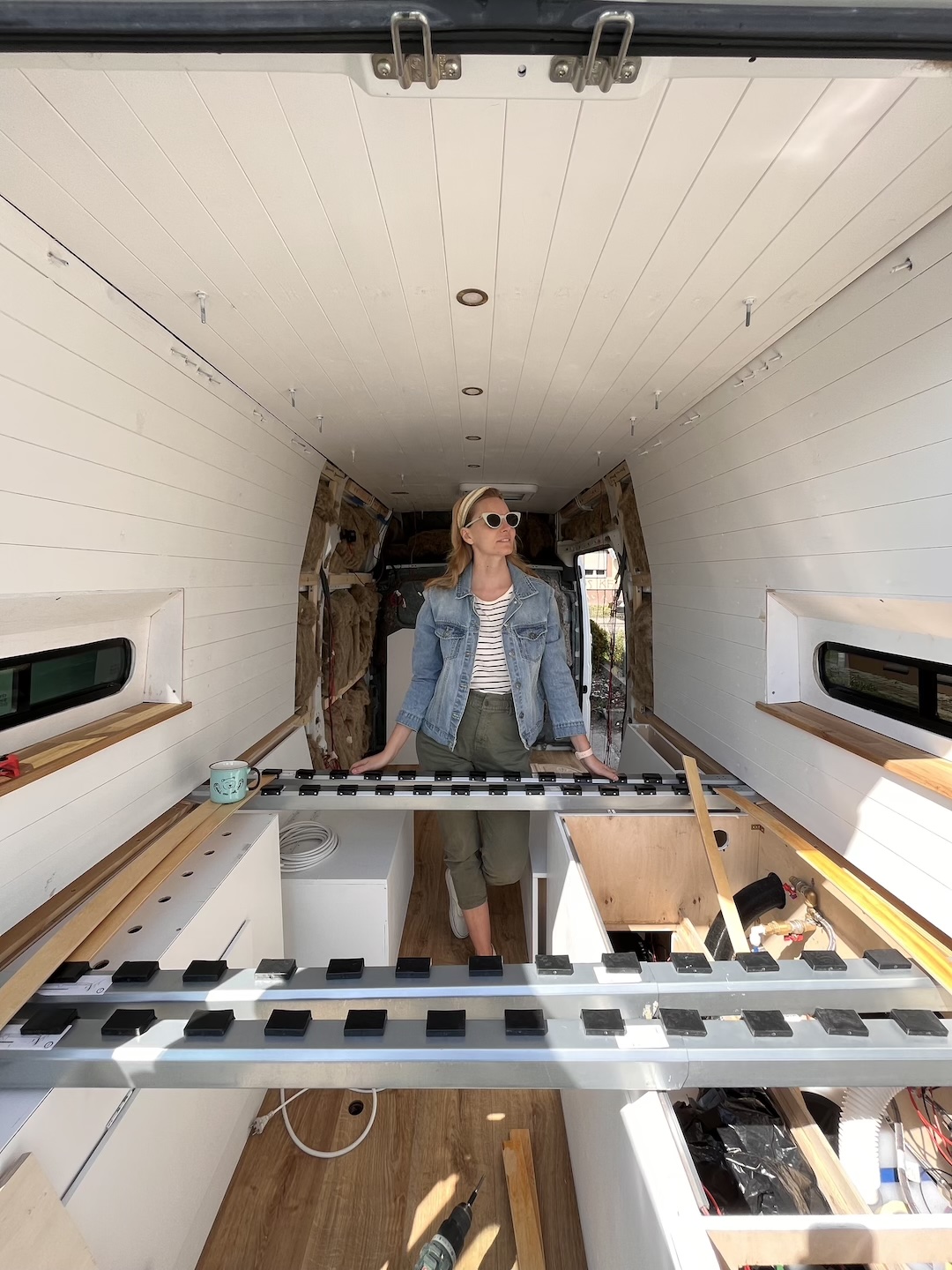
In the end, we chose a pull–out design positioned above our seats and table.
During the day, part of the bed becomes our seating area, supported by a Lagun leg system. The table swivels, creating a flexible space for eating or working.
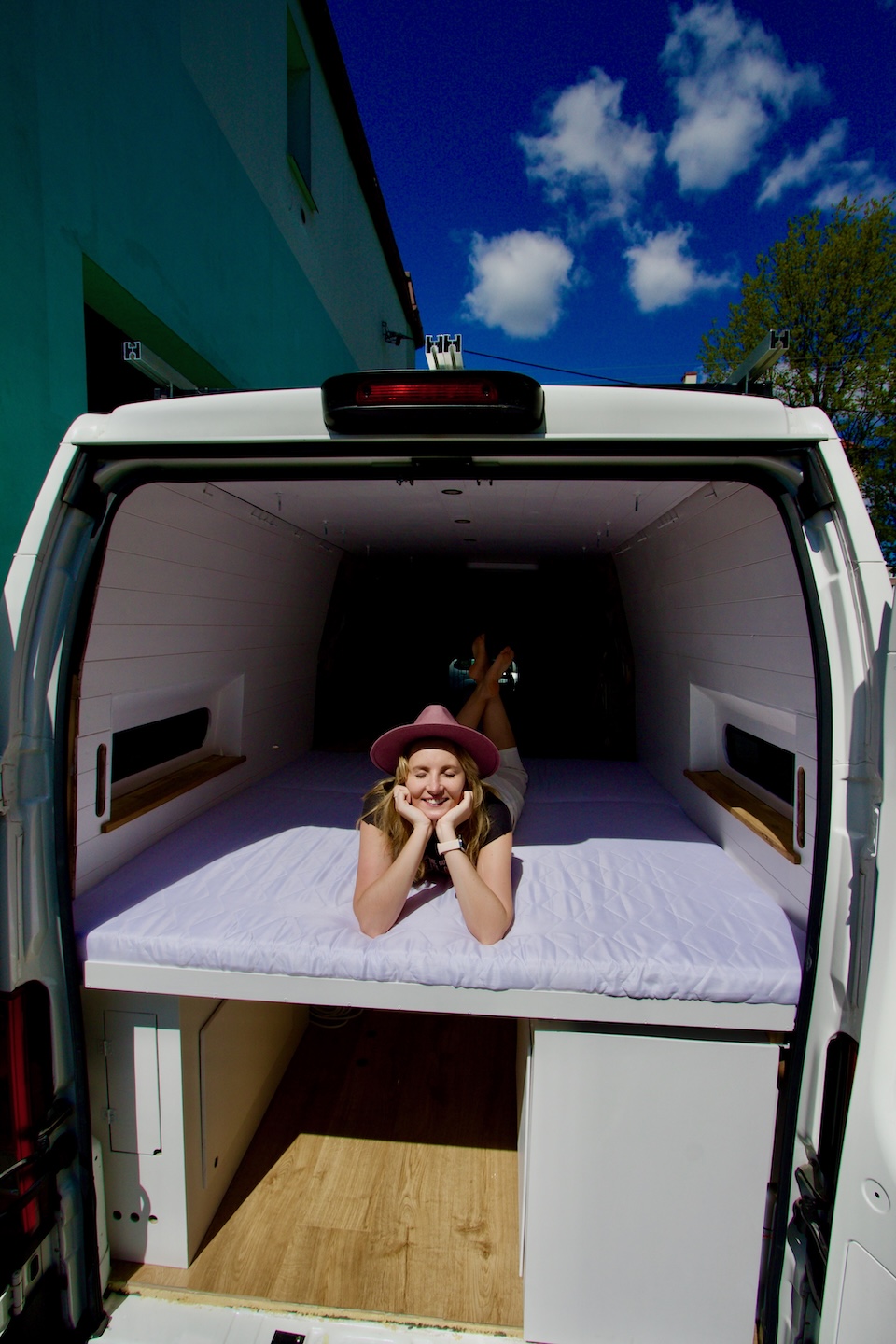
8. Kitchen Area: More Than Just Cooking
Kitchen Requirements
In Poland (where I’m from), RVs legally must have a designated food preparation area. Our kitchen includes:
- A stainless steel sink with a pull-out faucet
- A countertop made from 2 cm (0.8 inch) solid oak
- A flameless gas cooktop
- Storage cabinets and drawers built from plywood
We also installed a 12V camper refrigerator, which is more efficient for long-term travel than a portable cooler.
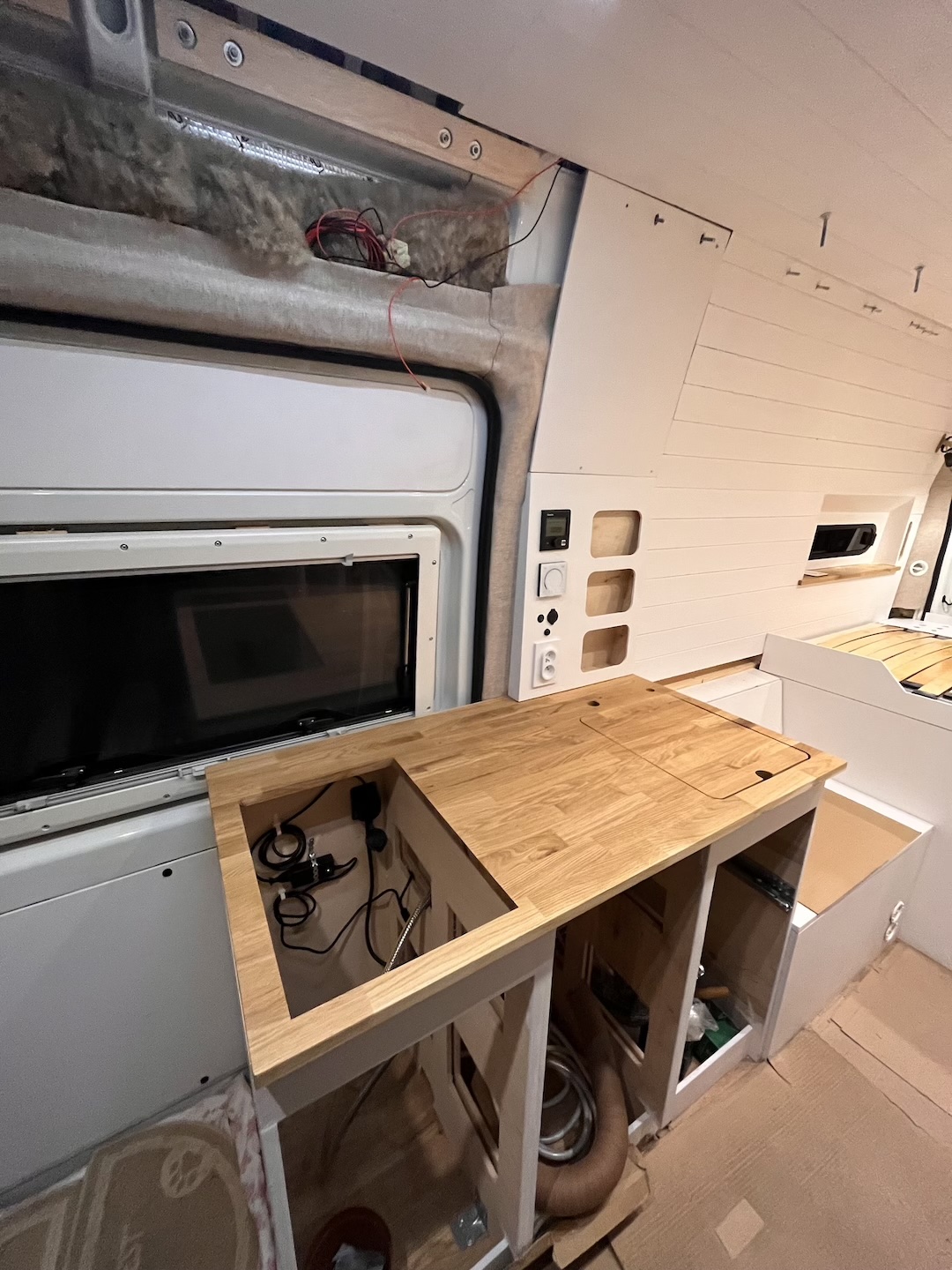
9. Bathroom: Luxury or Necessity?
Adding a bathroom is optional, but it gives you incredible freedom. No more hunting for public restrooms or campground facilities!
Our tiny bathroom (100 × 60 cm or 39 × 24 inches) includes:
- A 60 × 60 cm (24 × 24 inches) shower tray
- A composting toilet (Nature’s Head brand)
- A door that creates a shower stall when closed
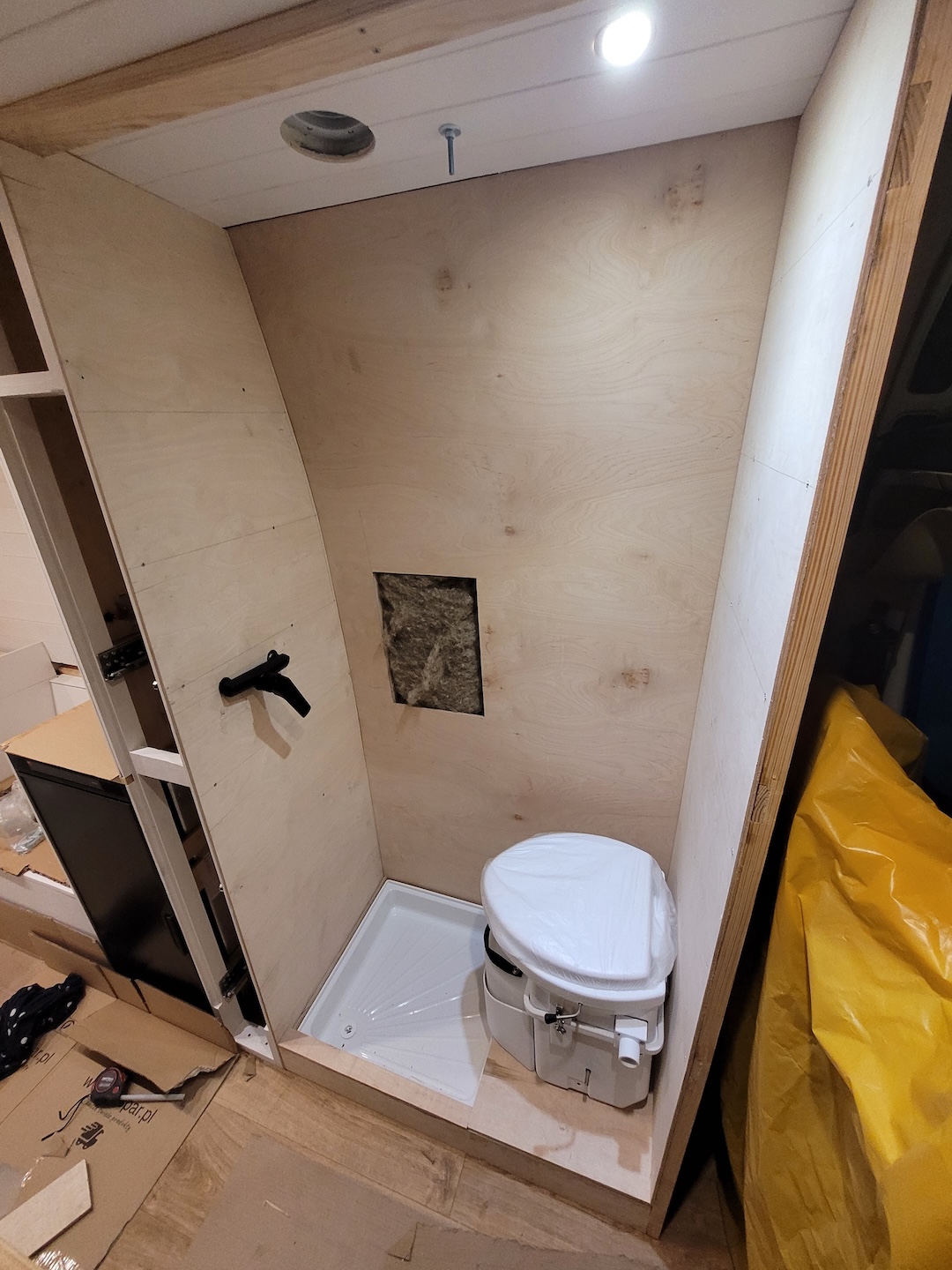
We built the shower enclosure from marine–grade plywood sealed with yacht paint for waterproofing. Getting all the corners waterproof was tricky, but worth the effort.
We chose a composting toilet over a chemical one because it’s more eco–friendly and easier to manage on long trips. Yes, it was more expensive initially, but we’re happy with the decision.
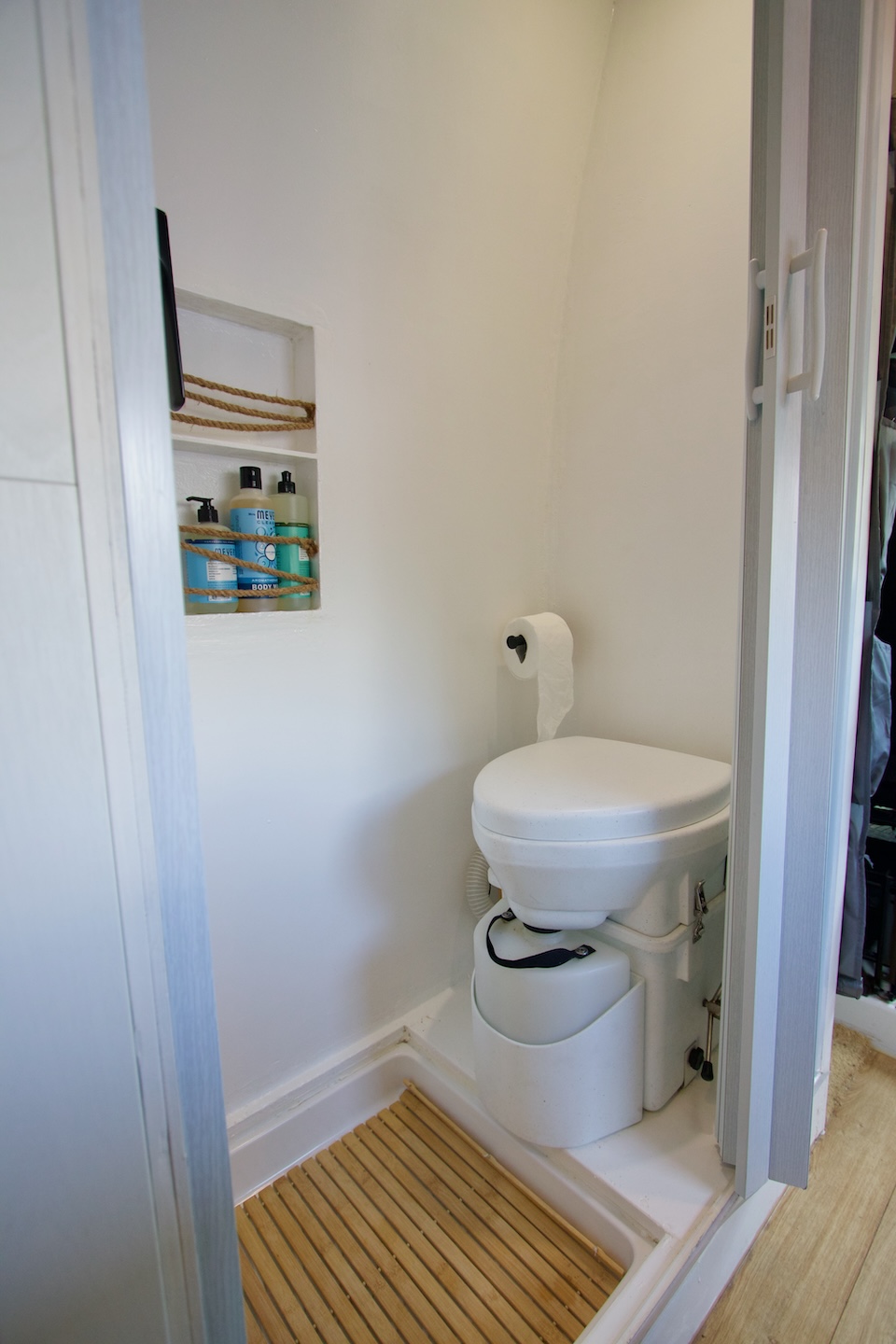
10. Making It Feel Like Home
For me, this was the most fun part! After months of construction, we finally got to make our van feel like home.
We wanted a cozy space that felt warm and personal, not like a sterile RV. We went for a coastal bohemian style with:
- Natural materials wherever possible
- Calming colors (mostly whites, blues, and natural wood tones)
- Personal touches like handmade curtains and cushions
- Small decorations that make us happy
While we kept things simple with standard solutions for the technical systems, we carefully chose interior accessories to match our vision.
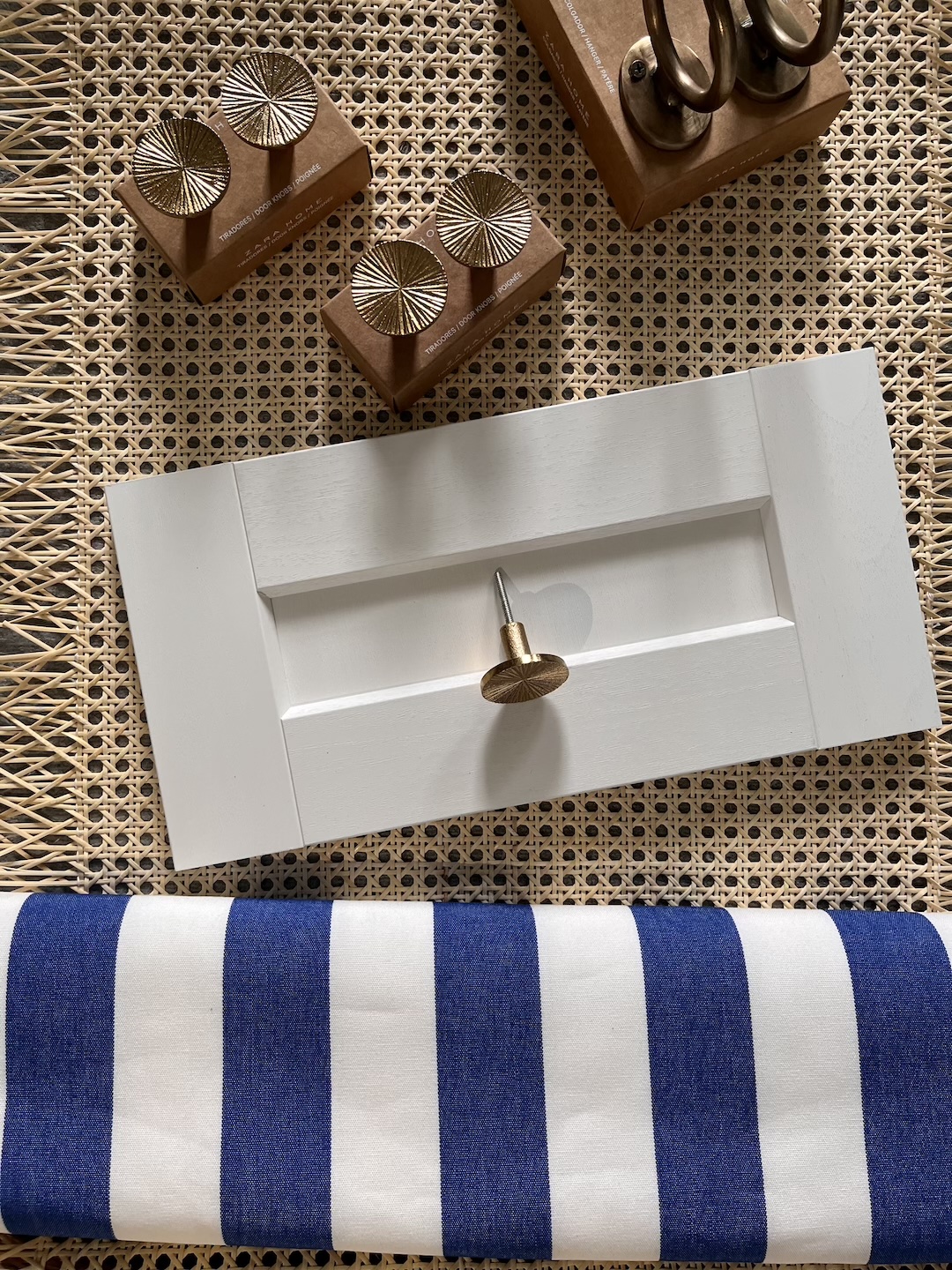
11. Essential Accessories
Beyond the built-in elements, we carry several accessories that make van life more comfortable:
- Folding camping chairs and table
- Yoga mat
- Thermal window covers (crucial for privacy and temperature control)
- Extra pillows and blankets that match our interior style
- Kitchen essentials (pots, utensils, etc.)
- Bathroom necessities
For utilities, we have:
- Basic tools for roadside maintenance
- A water hose with different tap attachments
- A heavy–duty power cable
- Leveling ramps for uneven parking spots
Once you’re on the road, you’ll discover even more ways to optimize your setup. My 20 Genius Vanlife Hacks covers all the clever tricks I’ve learned from actual van life experience!
12. Registration and Paperwork
The final hurdle was registering our conversion as an official RV. In Poland, this meant meeting basic requirements:
- Having a designated sleeping area
- Including a food preparation space
- Having seating and a table that can be stowed while driving
We also had to pass a technical inspection, weigh the vehicle, pay excise duty, and submit the right paperwork.
Regulations vary by country, so research your local requirements before starting your build!
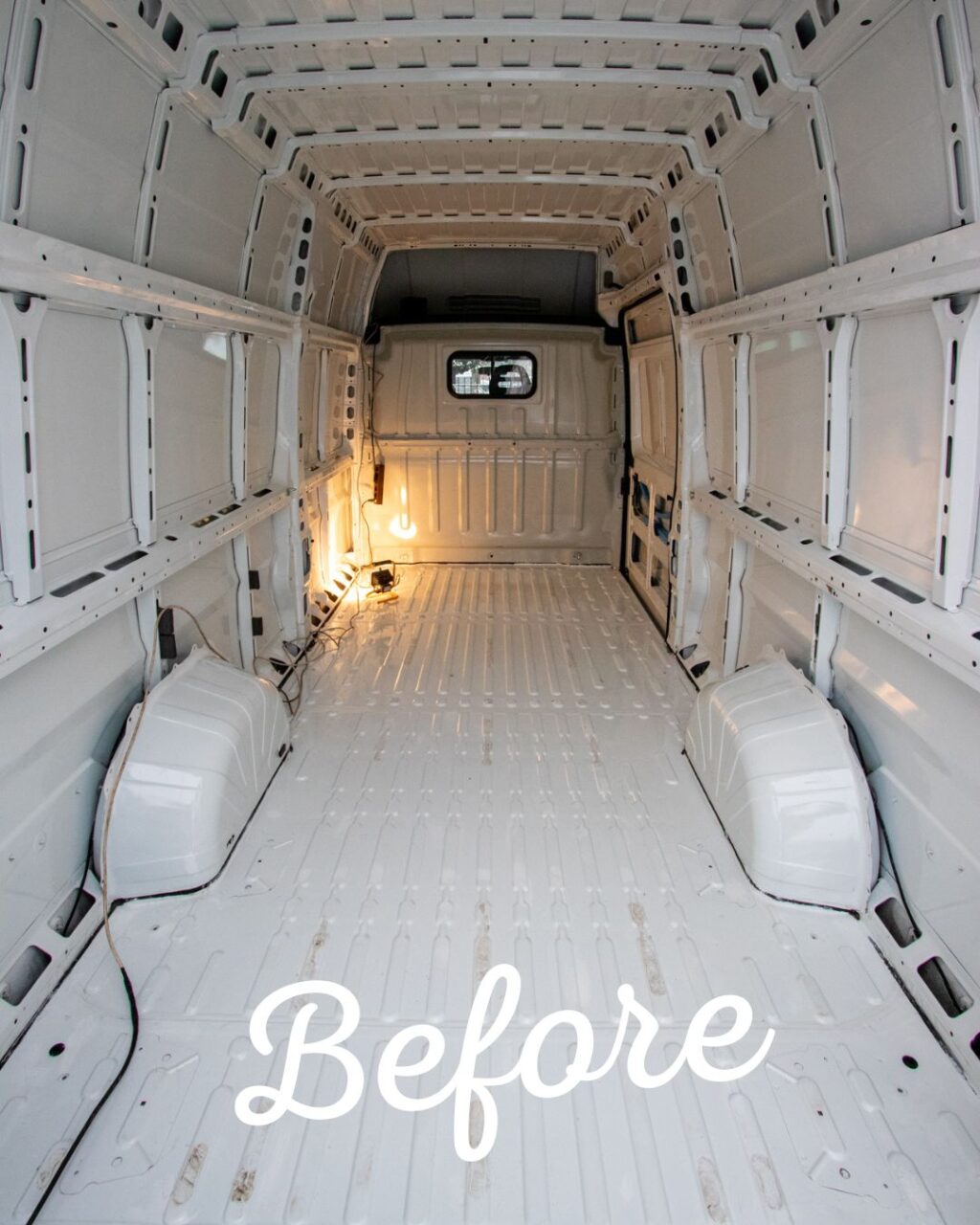
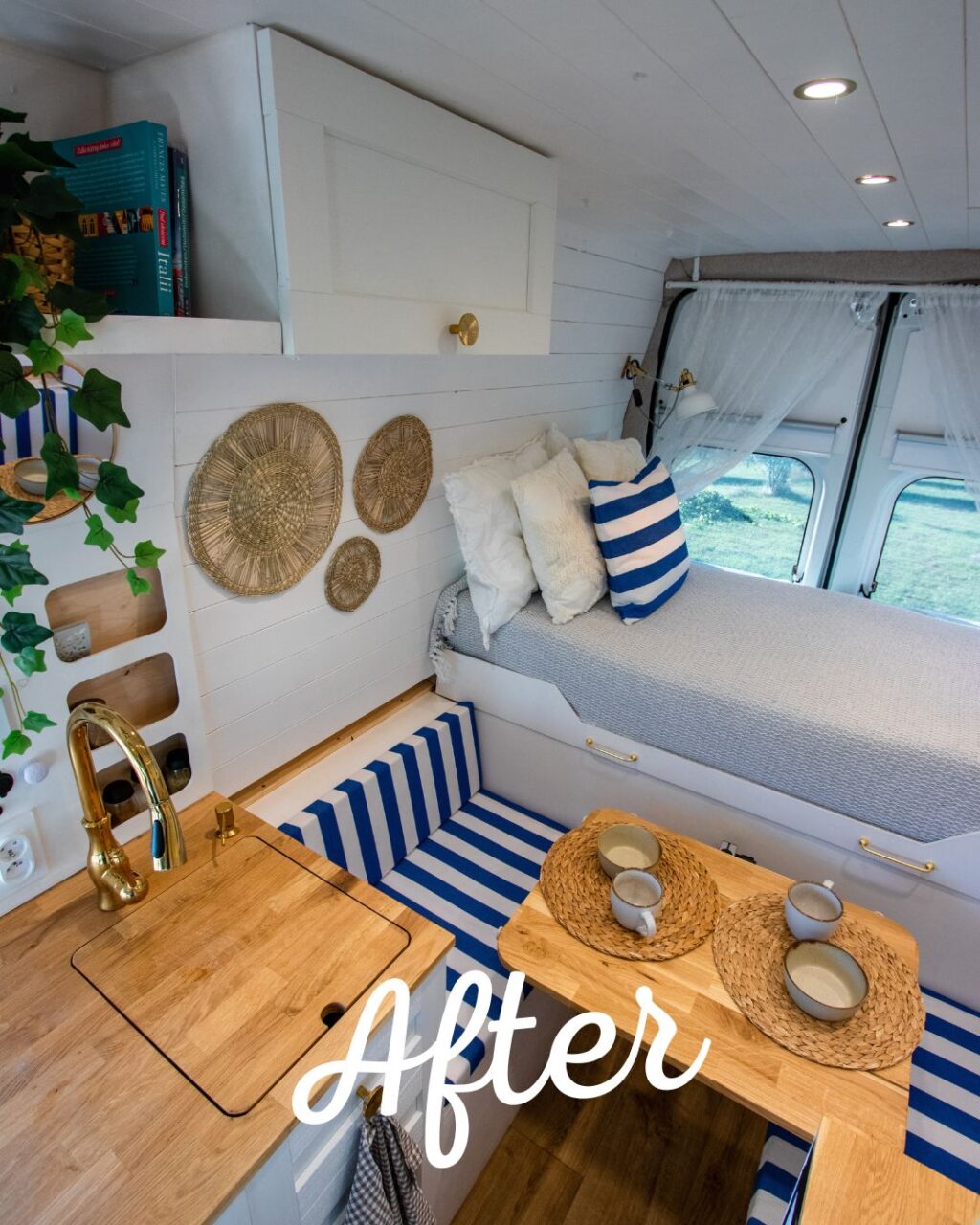
What’s your next step in the van conversion journey?
🔧 Build essentials → My practical tips for avoiding common mistakes
❓ Got questions? → Everything I wish I’d known before starting
⚠️ Before you start → Critical preparation steps that can save you thousands
🎒 Van life ready? → Real-world tips from the road
What aspect of van building excites (or scares) you most?
Skills You’ll Need (Or Learn Along the Way)
Building a campervan taught me skills I never thought I’d have! You don’t need to be an expert in everything before starting, but you’ll definitely learn:
- Woodworking – Most of your interior will be custom-built from wood
- Basic electrical knowledge – Understanding 12V vs. 230V systems
- Plumbing – Setting up water tanks, pumps, and pipes
- Gas safety – This is one area where professional help might be worth it
- Metalwork – For cutting holes in the van for windows and vents
The learning curve was steep, but there are amazing resources online. I spent countless evenings watching YouTube tutorials and reading blog posts from other van builders.
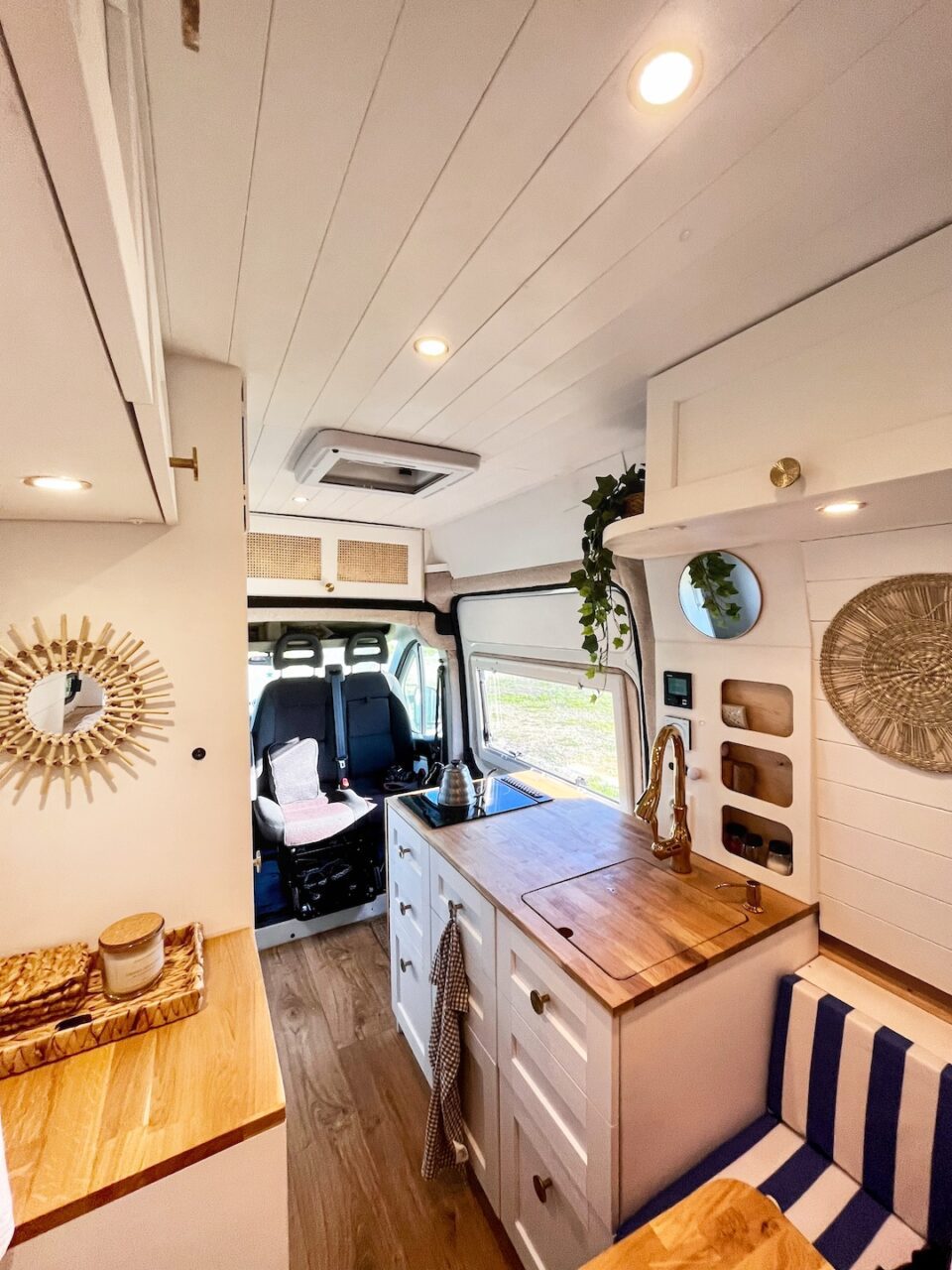
FAQ: Questions I Get Asked Most Often
What insulation materials work best?
Look for materials with good thermal properties that are also non–flammable and non–toxic if possible. We chose sheep wool for most areas because it’s natural, handles moisture well, and doesn’t contain harmful chemicals.
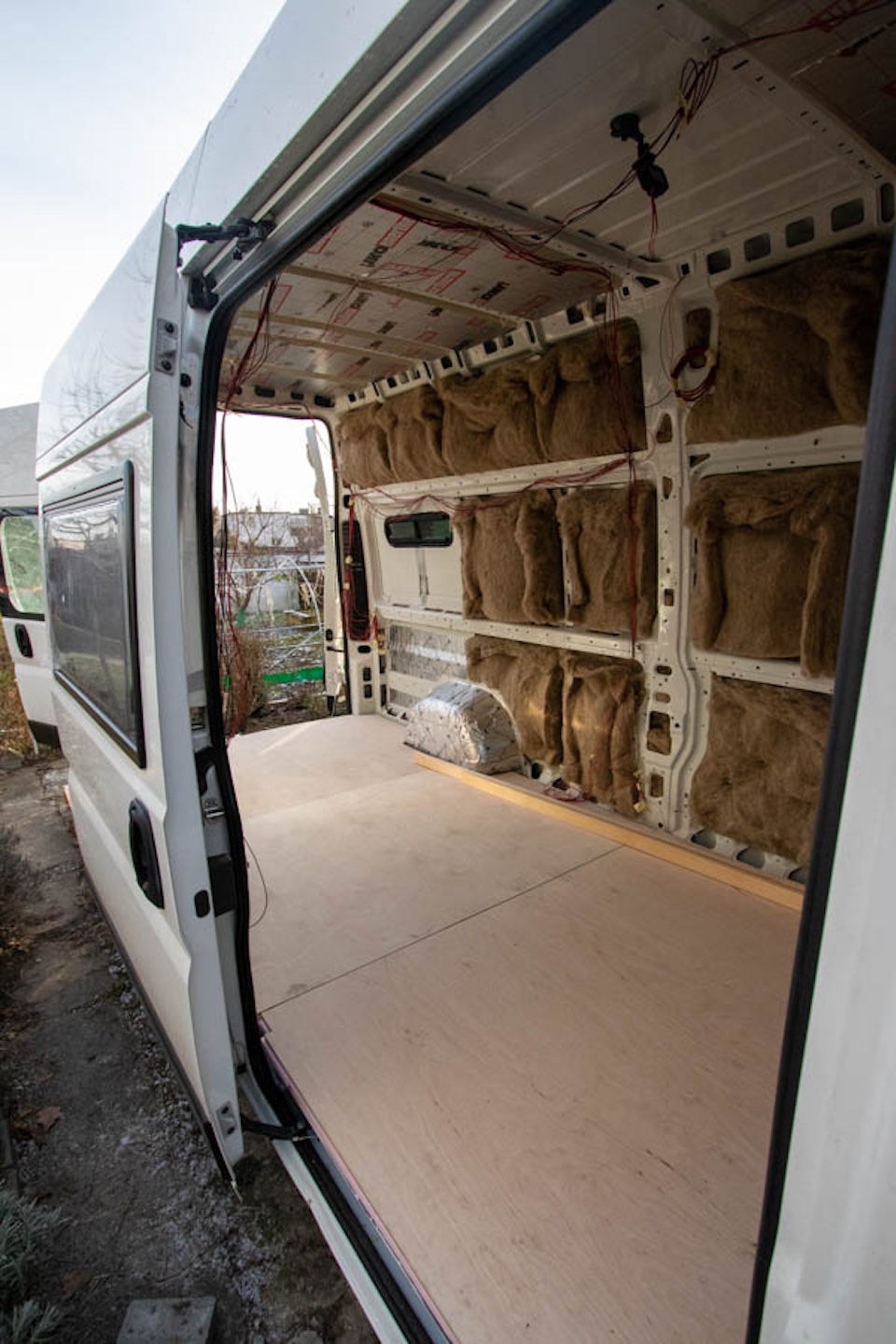
What materials should I use for cabinets?
Birch plywood is the standard choice, available in various thicknesses:
- 3 mm (0.12 inch) for decorative elements
- 6.5 mm (0.26 inch) for lightweight parts
- 12 mm (0.47 inch) for most cabinets
- 18 mm (0.71 inch) for structural components like seats
What tools helped with design?
There are plenty of tools to help design your campervan. Here are a few that might come in handy:
- Excel or Google Spreadsheets: Super useful for estimating costs and keeping track of your budget during the build process.
- Pinterest: A great platform for finding inspiration, ideas, and creating mood boards for your campervan project.
- SketchUp: A free online design tool that’s perfect for designing cabinets or the entire van layout. It might take some practice, but there are tons of tutorials to help you get started.
- Pen and Paper: Perfect for simple sketches and noting down exact measurements (make sure to double-check those!).
- Cardboard, Plywood Templates, etc.: Great for making mock–ups of your campervan’s structure or cutting identical parts.
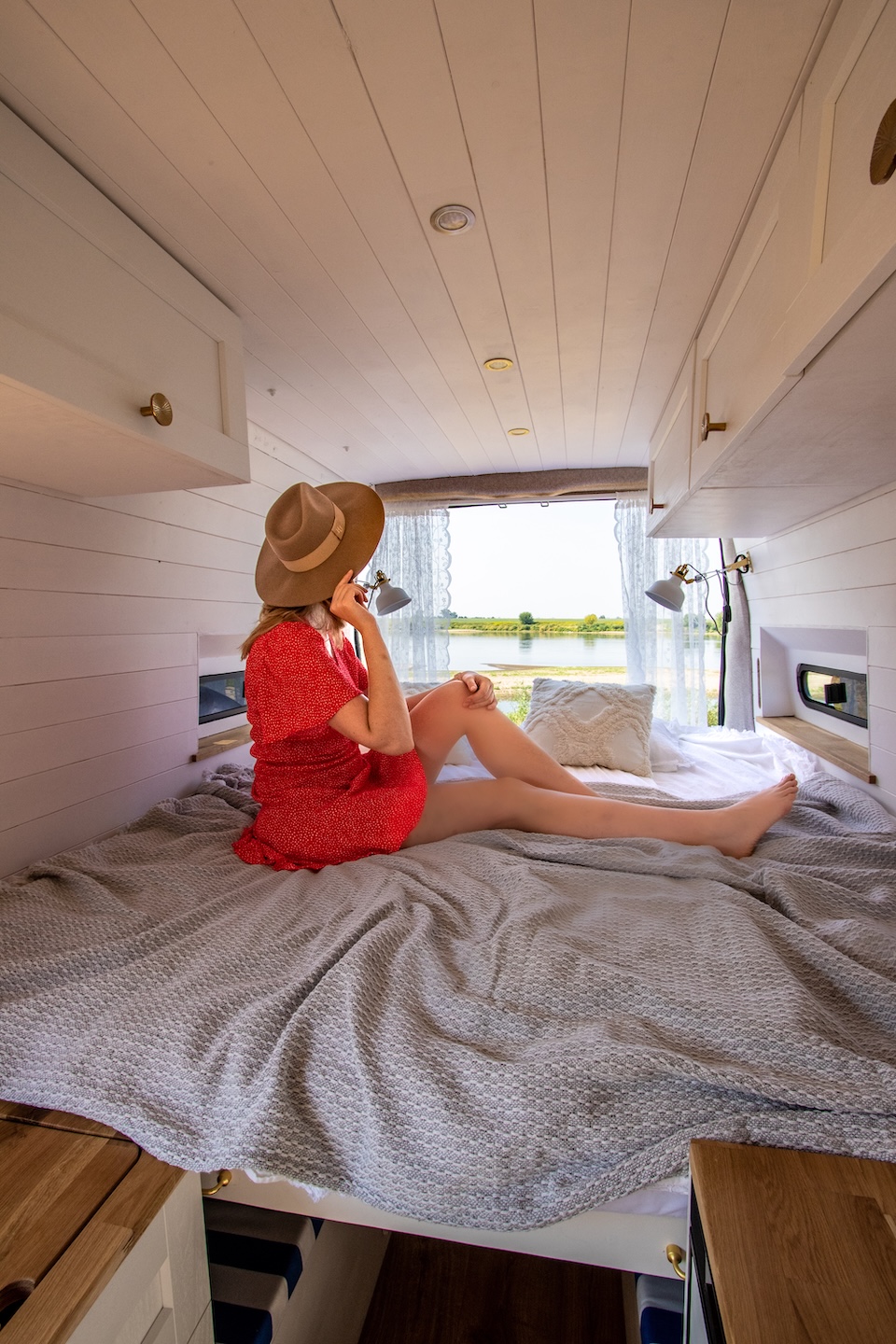
How much did it cost?
Our complete conversion (not including the van itself) cost about €16,000:
- Water, gas, and heating: €4,500
- Electrical system: €3,000
- Insulation, windows, ventilation: €2,500
- Cabinets and furniture: €2,500
- Bathroom and kitchen: €3,000
How long did it take?
From start to finish, about 8 months of working mainly on weekends. We both have full-time jobs, so our build progress was limited to evenings and days off.
Check Out Our Video On How to Build a Campervan!
Travel Budget Calculator
Get your free Travel Budget Calculator now and plan your trip without the stress of overspending!
How to Build a Campervan: My Final Thoughts
Building our campervan was honestly one of the most challenging and rewarding projects I’ve ever tackled.
There were definitely moments when I questioned our sanity – like when we were troubleshooting the electrical system for the third time, or when I realized we’d measured the bathroom door wrong!
But sitting here now, writing this in our van parked next to a lake in Europe, I can tell you it was all worth it. Every late night spent researching, every weekend covered in sawdust, every “why didn’t we just buy a ready-made RV?” moment led to this.
What makes a self-build special isn’t just saving money (though that’s nice too). It’s knowing exactly how everything works, being able to fix things yourself, and having a space that’s 100% tailored to how YOU want to travel.
Our van isn’t perfect – I still notice little things I’d do differently next time. But it’s OURS, and every quirk and imperfection tells the story of how we learned to build something together.
Ready to start your own van conversion adventure?
- Build Planning Guide – avoid my mistakes with proper preparation
- 20 Must-Know Questions – plan like a pro
- Van Life Hacks – real-world tips from someone who’s lived it
- Layout Inspiration – steal ideas from successful builds
What’s holding you back from starting your van build? Let me know in the comments – I love helping fellow builders work through challenges!
Save this guide for later and share it with anyone dreaming of van life – building a community of van builders makes everyone’s journey easier!
